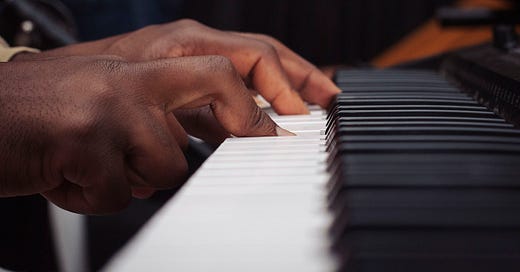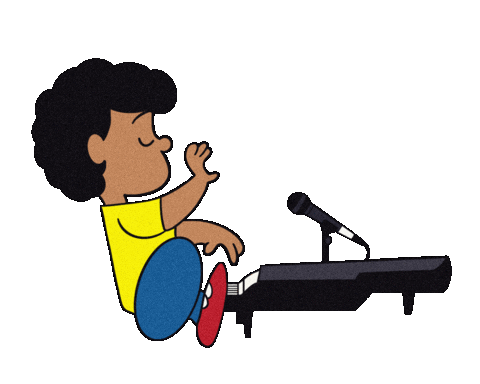Understanding the Downturned Point in Music
Analyzing the tingles within a good ballad from the 1970s to 2010s
Over the years, ballads became my go-to music niche. Ballads are like a wave of emotions. Within those waves comes what I call the “downturned point.” The downturned point is how I decode what soothes me the most in a song.
The “downturned point” is the point of a song where you feel it is reaching your heartstrings - causing you to swoon. It can show itself in minor and even major keys of songs, chord transitions, and song lyrics. For me, this is how I break down music every day. It’s what makes me want to play a song on repeat.
In this article, we will learn what builds a downturn point and the ballads where songs stand out from the ‘70s to the ‘10s.
What Builds a Downturned Point
To understand the downturned point, you must understand how ballads are composed.
First, you have songwriters who create the emotional lyrics. Second, the singer/producer decides what instruments they want. The standard are pianos and guitars. Occasionally, an artist may opt for a string section to fill in the emotional tides. Third, you have the vocals. Lead vocals are from the recording artists, but background vocals help complete the song.
All of these elements generally build the downturn point. However, it's strategic in how these elements create the right downturn. For instance, a song can have a piano, string section, and great lead vocals. Or it can be a folk song with a guitar and no string section. Vocal arrangements help build a song's memorability. Background singers can be pivotal in creating harmony for that downturned point. Usually, head notes and falsettos can highlight that moment. Technical singers like Aretha Franklin, Whitney Houston, and Mariah Carey specifically make them known in their ballads.
So how are the downturned points heard in songs? Let’s go through them.
1970s
In the 1970s, the downturned point was all in the melody and production. I will give you examples from Stevie Wonder and the Bee Gees.
Stevie Wonder - You and I
Stevie Wonder is a great musical genius. Now, I could’ve chosen other ballads from him, but I chose this one for analysis. “You and I” is a song in the key of C major where his vocals and piano skills play in. The downturn point is in the chorus. The chorus happens to merge into the verses of the song. In the lyrics, the downturned point stands out to make a message. Lines like: “In my mind, we will conquer the world.” It's followed by low notes on the piano. People can feel the warm romance with those words.
Bee Gees - How Deep Is Your Love
Since their blue-eyed soul debut, the Bee Gees gave us hit after hit in America. They moved us with ballads like “How Deep Is Your Love.” It’s in Eb major. It’s memorable for its driving melody. Their signature 3-part harmony takes us to the downturned point in lines like “cause we’re living in a world of fools breaking us down when they all should let us be.” The section gives us the right slow dance. Their vocals and soft synths bring the most beautiful results.
1980s
The 1980s was the decade of power ballads with the occasional soft ballad on the side. The Bangles carried the downturned point in their power ballad “Eternal Flame” while Lionel Richie carried softly with “Hello.”
The Bangles - Eternal Flame
This song gravitated to me for its melody. The ballad is like a music box with a string section. It’s a romantic ballad about falling in love. Its shift from B major to C major brings out the downturned point. That’s what I love about the song. There’s a lot of sentiment that pulls through the chorus. The chorus repeating itself as a coda makes it a strong melody.
Lionel Richie - Hello
Lionel Richie’s “Hello” is one of those 80s ballads you can recite many times. It’s the key of A minor. The downturned points are in the chorus. Those parts bring out the yearning themes. It uses vocals, an electric piano with an acoustic guitar at the bridge. So, you’re getting a mix of almost everything. The acoustic bridge reminds me of DeBarge’s “All this Love” having a Latin flair.
1990s
The 1990s was the era for big R&B vocals and alternative rock bands. While vastly different genres, they created downturned points in their songs.
Toni Braxton - Breathe Again
When we think of vocals, this Grammy-award-winning song is full of them. The key is in D major. The downturn point is noticed in the lead and background harmonies. Toni being a part of LaFace Records puts her in the signature Babyface sound. It chimes in rhythmically as an R&B staple. The downturned point is in the lyric “Please understand if love ends.” When you think of the delivery and the song lyrics, the song comes together.
Radiohead - Creep
Radiohead’s “Creep” is known for its cynical lyrics. It’s in the key of G minor. You really feel how depressing the song is. It sets the mood with its guitar and bassline. Thom Yorke’s voice also puts everything together for its downturned point. The chorus “I’m a creep..I’m a weirdo” pauses in the middle and then connects again.
2000s
The 2000s saw pop and R&B still reaching the top of the charts more frequently. Here is how two top ten ballads used downturned points.
Mary J Blige - Be Without You
There’s a lot of soul in “Be Without You.” It’s in the key of A minor. The vocals, piano, and rhythm make this a typical 2000s R&B song. The piano riff lets you know what to expect from this love song. The melody drives the downturned point even throughout the bridge. The final belt also moves the song smoothly.
James Blunt - You’re Beautiful
There were a lot of songs that moved me in the 2000s. It’s in Eb major. One popular random ballad that has these downturned points is “You’re Beautiful.” Its melody is catchy and heartful. The downturned is heard at the end of the chorus. “And I don’t know what to do.” That part really breaks your heart for that one split moment because you feel his agony. I think this song also works wonders as him being a Pisces as all.
2010s
The 2010s saw the era of the contemporary pop vocalist. The downturned point is noted by artists like Sam Smith and Adele.
Sam Smith - Writings on the Wall
I picked this song because of its rich string section. The key is in F minor. Its downturn point is in the strings, vocals, and piano. The piano introduces the tone while soaring higher in the chorus. I love it when the chorus ends softly: “For you, I have to risk it all.” Sam executes the line beautifully. The downturn definitely gives you chills. It sets up the perfect theme for the Spectre movie.
Adele - All I Ask
Adele is known for her contemporary ballads. One of her best solo cuts was “All I Ask.” It merges Adele’s rich vocals with a piano. It's stripped down and beautiful in its delivery. This song is another example of when a piano melody marries the voice of the artist. Hear the downturn point in the transition to the pre-chorus and chorus. Lines like “Take me by the hand while we do what lovers do.”
Recap
As we’ve learned, the downturned point is the part of the song where the emotion makes you swoon. It brings the listener empathy. Think of it as a moving transition between chords.
It’s built by vocals and various instruments like the piano and guitar. An orchestra can also create the downturned point with its string section.
Each decade has at least one hit ballad where the downturned point is heard. The 70s had singers like The Bee Gees. The 80s had great soul songs with Lionel Richie. The 90s had vocalists like Toni Braxton bringing the point out off her first album. The 00s had Mary J Blige bring out her feelings on records. The ‘10s saw Britain’s songstress Adele move us with her vocal tones.
All and all, the downturned proves music’s powerful spectrum. It let’s us know that music can be constructed to our control. No matter what period, it becomes magic to our ears.
Thanks for reading.
I hope you learned something new about music. Stay tuned for my music education stories.
Name me some downturned points you can think of. 🎶





